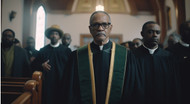COGIC Vestments: A Symbol of Authority, Dignity, and Tradition
Jun 13th 2023
The attire worn by clergy members holds significant meaning within religious traditions. It serves as a visual representation of their authority, dignity, and adherence to cherished customs.
Within the Church of God in Christ (COGIC), vestments play a vital role in embodying these values. From the rich history of COGIC to the specific types of vestments worn, each aspect contributes to the profound symbolism and importance of these garments.
The History of COGIC Vestments
In 1895, two prominent African American ministers, Charles Harrison Mason, and Charles Price Jones, established the Church of God in Christ (COGIC) in Lexington, Mississippi.
Their humble beginnings took shape in an abandoned cotton gin building, marking the birth of a religious movement that would have a profound impact on the African American community. Following the passing of Bishop Mason in 1961, Charles Price Jones assumed the role of the church's bishop.
Later, Bishop J. O Patterson Sr., Mason's son-in-law, succeeded him. In 1970, Bishop Patterson established the C.H. Mason Theological Seminary in Atlanta, Georgia, where he introduced a significant change to the attire of COGIC ministers during worship services.
The traditional suits and ties were replaced with more formal ecclesiastical vestments, now recognized as COGIC vestments.
The Significance of COGIC Vestments
COGIC vestments hold profound significance, encompassing both the authority and dignity of the clergy and the deep-rooted traditions within the church. At a fundamental level, these vestments symbolize the clergy's commitment to their divine calling.
The cassock, a long and flowing robe, is worn by all COGIC clergy as a visible representation of their sacred office and devotion to serving the church.
Adorned over the cassock, the surplice, a sleeveless white garment, further embodies purity and holiness.
The tippet—a short black scarf worn around the neck—signifies authority and leadership.
Lastly, the stole, a long and narrow scarf draped over the shoulders, signifies the clergy's role as ministers of the Gospel.
Beyond their visual significance, COGIC vestments serve as a link to the church's rich history and tradition.
The colors predominantly used for these vestments, black and purple, pay homage to the African American community from which the church emerged.
Additionally, the intricate gold and silver trim on the vestments symbolizes the church's unwavering commitment to excellence and its relentless pursuit of upholding the highest standards of Christian living.
When COGIC clergy dons their vestments, they not only represent themselves but also carry the responsibility of representing the church and its values.
These vestments serve as a visible reminder of the church's authority, dignity, commitment to purity, holiness, and the richness of its historical roots and tradition.
Apart from their symbolic meaning, COGIC vestments also serve practical purposes within the worship service. They help distinguish the clergy from the congregation, fostering a sense of order and decorum.
Moreover, these garments provide comfort and security to the church, enabling them to fulfill various tasks during worship services, such as preaching, leading prayers, and administering communion.
Overall, COGIC vestments serve as a powerful symbol, encapsulating the church's authority, dignity, and rich tradition.
While their practical functions are essential, it is their deep symbolic meaning that enriches the worship experience for both the clergy and the congregation.

The Different Types of COGIC Vestments
Cassock: The cassock, a long and flowing robe, is a staple garment all COGIC clergy wears. Typically made from a variety of materials such as silk, satin, or wool, it is available in black or purple.
- Surplice: Worn over the cassock, the surplice is a sleeveless white garment, usually crafted from linen or cotton. Often embellished with gold or silver trim, it adds an element of grandeur to the clergy's attire.
- Tippet: A narrow black scarf worn around the neck, the tippet complements the ensemble. Made from silk or satin and embellished with gold or silver trim, it adds an additional touch of authority and distinction.
- Stole: Draped over the shoulders, the stole is a long and narrow scarf made from silk or satin. Like the other vestments, it is often adorned with gold or silver trim. The stole specifically represents the clergy's role as ministers of the Gospel.
In addition to these fundamental vestments, COGIC clergy may also wear other garments, including choir robes, choir surplices, or choir tippets. While primarily worn by choir members, these garments may be worn by clergy members who lead the choir.
The specific type of vestments worn by COGIC clergy varies depending on their rank and the occasion. Bishops typically don more elaborate vestments compared to elders. Furthermore, different vestments may be worn for specific services such as baptisms, weddings, or funerals.
Overall, the various types of COGIC vestments allow clergy to express their faith and honor the traditions of the church. They also play a vital role in establishing order and decorum during worship services.
Where to Buy COGIC Vestments
When in search of impeccable ecclesiastical vestments, Divinity Clergy Wear is the ultimate destination. Offering a wide variety of styles and colors at reasonable prices, they cater to the diverse needs of clergy members.
If you're seeking the Class A COGIC vestments, visit our website at DivinityClergyWear.com and discover the ideal attire to embody your authority, dignity, and tradition.
